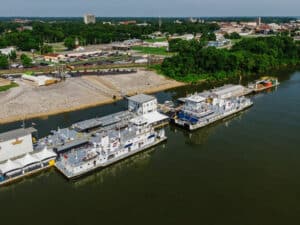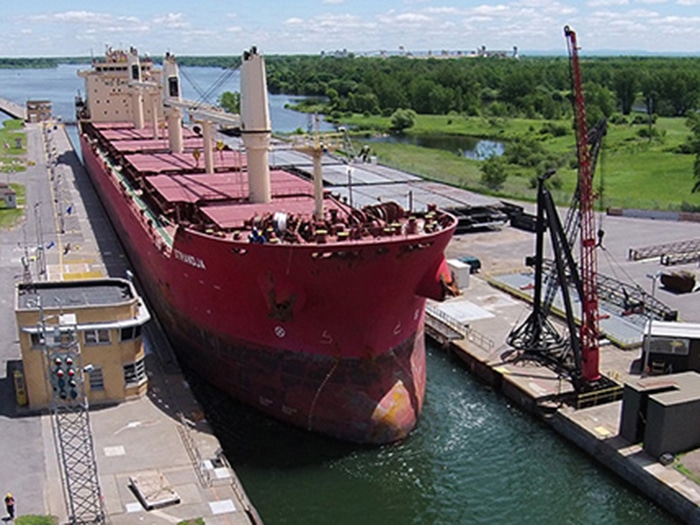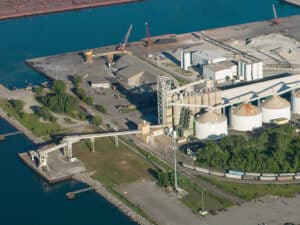
Study details investments on Great Lakes St. Lawrence Seaway System
Written by Heather Ervin
Credit: Seaway Administration
On December 13, the Great Lakes St. Lawrence Seaway Development Corporation (GLS) announced the release of an independent survey of public and private infrastructure investments to enhance marine shipping on the Great Lakes St. Lawrence Seaway System.
These investments sustain 241,286 U.S. and Canadian jobs and help contribute to the safe, efficient, and sustainable movement of the135.7 million metric tons of cargo that moves along the Great Lakes St. Lawrence Seaway. The survey conservatively estimates that $8.4 billion has been or is committed to be spent on Great Lakes/Seaway infrastructure investments between 2018-2027.
Prepared by Martin Associates of Lancaster, Pa., and titled, “Infrastructure Investment Survey of the Great Lakes and St. Lawrence Seaway System,” the survey quantifies recent and ongoing investments in the navigation system that help support long-term planning and the achievement of economic development goals, while also building confidence in the Great Lakes Seaway System’s future viability.
“The survey’s conclusion is clear: both the public and private sector recognize that maritime commerce on the Great Lakes and St. Lawrence Seaway remain essential to the economies of the United States and Canada, and are investing to protect this irreplaceable system,” said U.S. Transportation Secretary Pete Buttigieg. “Through President Biden’s infrastructure law, we are investing in marine shipping, which will continue to support high quality jobs, strengthen America’s supply chains, and drive sustainable economic growth.”
“The Great Lakes St. Lawrence Seaway System and its countless ports, terminals, ship owners, and cargo owners support the most sustainable and cost-effective way to haul goods to and from North America,” said Adam Tindall-Schlicht, GLS Administrator. “The importance of this vital conduit for North American trade is clear, and this survey shows that governments and the maritime industry are jointly focused on supporting marine shipping’s environmental and technological leadership through significant ongoing investment. Simultaneously catalyzing this robust trade corridor is the goal.”
The survey, which reported $8.4 billion in infrastructure investments between 2018-2027, identifies specific categories of investment including:
- $636 million invested in vessel enhancements between 2018 and 2022 for new ships and vessel upgrades, with at least another $328 million planned between 2023 and 2027.
- $2.1 billion invested to enhance port and terminal infrastructure between 2018 and 2022, with at least another $1.1 billion planned between 2023 and 2027.
- $3 billion invested in waterway infrastructure, including locks, breakwaters, and navigation channels, between 2018-2022, with at least another $1.2 billion planned between 2023 and 2027.
These results reflect a conservative measure of future investments in the navigation system, as we expect more investments to be made between now and 2027. Also, this survey does not seek to quantify expenditures for routine maintenance and repairs.
The survey is part of a larger project undertaken by a public/private sector committee of American and Canadian maritime organizations, including the GLS and the Canadian St. Lawrence Seaway Management Corporation. That project produced a study titled, “Economic Impacts of Maritime Shipping in the Great Lakes-St. Lawrence Region,” released in July. That study found that maritime commerce on the Great Lakes Seaway System annually sustains 241,000 U.S. and Canadian jobs, $36 billion in economic activity, $18 billion in personal income, and $6 billion in federal, state/provincial, and local taxes each year.
In addition to the billions invested by private marine shipping organizations in research and development, new infrastructure, and new service offerings, the survey captures major governmental funding initiatives aimed at enhancing infrastructure and improving supply chains. This public investment is led by the Biden Administration’s Bipartisan Infrastructure Law and Inflation Reduction Act, which are aimed, in part, at investing in green technologies and transportation infrastructure enhancements.

![Tom Frazier aground and listing to starboard on Feb. 11, 2024. [Photo: U.S. Coast Guard]](https://www.marinelog.com/wp-content/uploads/2025/06/Towboataground-300x225.jpg)


